Theory
Puzzle Test is one of the easiest and important concepts of General Mental Ability Segment of Reasoning. In this type of test, the questions are based upon the given data belonging to different groups or possessing different qualities. Here, you will learn to analyse the given data and solving problems by constructing a proper table or chart.

Types of Puzzle Reasoning
Now that we know what logical reasoning puzzles are, let us see the various types of questions that may come in your competitive exams.
1. Floor Puzzle
In this type of logical puzzle reasoning, information of people living on different floors of the same or different building will be given. Candidates need to arrange them according to the given information.
2. Scheduling Puzzle
In this type of puzzle reasoning, data based on months, days, or years will be given.
3. Double Line up / Multiple Variable Puzzle
In these type of puzzle reasoning questions, information about different people will be given. Candidates need to arrange them according to the given data.
4. Linear Puzzle
In this type of logical puzzle reasoning, candidates need to arrange people in a row or multiple rows according to the given conditions.
5. Square Puzzle
In these type of puzzle reasoning questions, candidates are required to arrange different people around a square table.
6. Box Puzzle
In this type of puzzle reasoning, candidates need to arrange the boxes one above another.
How to Solve Logical Reasoning Puzzles - Know all Tips and Tricks
Candidates can find various tips and tricks from below for solving the questions related to the Puzzle reasoning section.
Tip # 1: A triangle has 3 corners and three sides, so three persons can sit at these corners and they are facing either the center or the direction opposite to the center.
Tip # 2: If A is three people away from B is given, then 3 – 1 = 2 people will sit between them.
Tip # 3: Candidates need to keep the following points in mind while solving the puzzle reasoning questions.
- When A is second to the left of B: A – B
- When A is second to right of B: B – A
- When A is 2 places away from B: A/B – – B/A
- When A is two places to the right of B or B is two places to the left of A: B – A
- When there are 2 people between A and B: A – – B
Tip # 4: The person born in the year 1990 is the order than the person born in the year 1992 or any year after 1990. The person born in January is older than the person born in March and so on.
Solved Examples
Problems Based On Comparison: In such problems comparison of different objects or persons has to be made. Such comparisons are done on the basis of marks, ages heights, etc.
Directions: Read the information given below to answer the given questions:
(i) 7 students A, B, C, D, E, F and G take a series of tests.
(ii) No two students obtain the same marks.
(iii) G always scores more than A.
(iv) A always scores more than B.
(v) Each time either C scores the highest and E gets the least, or alternatively D scores the highest and F or B scores the least.
Question for Tips & Tricks: Puzzle Test
Try yourself:If D is ranked 6th and B is ranked 5th, which of the following can be true?
Explanation
If you give a serious look to the problem you will find that such problems are as same as the arrangement problems. Therefore, we have to go like arrangement problem while solving problems based on comparison.
In this case, we see there is no definite information. Sentence 5 gives a definite information but it is conditional. Still, we draw all the possibilities based on sentence (v).
(1) C __ __ __ __ __ __ E
or (2) D __ __ __ __ __ __ F
or (3) D __ __ __ __ __ __ B
We see that the two additional informations (iii) and (iv) are inadequate to reach a definite conclusion. Hence, keeping these in mind. We move on to the given questions.
D is ranked 6th and B is 5th. This does mean that possibilities (b) and (c) are violated. Hence, possibility (i) must be true. Thus, we have:
C __ __ __ B D E
Also by virtue of (iii) and (iv) we can have only one arrangement for G, A and B which is GAB. Accordingly, there are three possibilities:
F G A F B D E
or C G F A B D E
or C F G A B D E
∴ Correct answer is (d)
Report a problem
Question for Tips & Tricks: Puzzle Test
Try yourself:If C gets most, G should be ranked not lower than_____
Explanation
If you give a serious look to the problem you will find that such problems are as same as the arrangement problems. Therefore, we have to go like arrangement problem while solving problems based on comparison.
In this case, we see there is no definite information. Sentence 5 gives a definite information but it is conditional. Still, we draw all the possibilities based on sentence (v).
(1) C __ __ __ __ __ __ E
or (2) D __ __ __ __ __ __ F
or (3) D __ __ __ __ __ __ B
We see that the two additional informations (iii) and (iv) are inadequate to reach a definite conclusion. Hence, keeping these in mind. We move on to the given questions.
∴ Correct answer is (c)
Report a problem
Question for Tips & Tricks: Puzzle Test
Try yourself:If D is ranked 2nd, which of the following can be true?
Explanation
If you give a serious look to the problem you will find that such problems are as same as the arrangement problems. Therefore, we have to go like arrangement problem while solving problems based on comparison.
In this case, we see there is no definite information. Sentence 5 gives a definite information but it is conditional. Still, we draw all the possibilities based on sentence (v).
(1) C __ __ __ __ __ __ E
or (2) D __ __ __ __ __ __ F
or (3) D __ __ __ __ __ __ B
We see that the two additional informations (iii) and (iv) are inadequate to reach a definite conclusion. Hence, keeping these in mind. We move on to the given questions.
D is ranked 2nd does mean possibilities (b) and (c) are false. Hence possibility (a) is true. Now look at the analysis of Question (a) and you will get the correct answer as: a.
Report a problem
Question for Tips & Tricks: Puzzle Test
Try yourself:If C is ranked 2nd and B is ranked 5th, which of the following must be true?
Explanation
If you give a serious look to the problem you will find that such problems are as same as the arrangement problems. Therefore, we have to go like arrangement problem while solving problems based on comparison.
In this case, we see there is no definite information. Sentence 5 gives a definite information but it is conditional. Still, we draw all the possibilities based on sentence (v).
(1) C __ __ __ __ __ __ E
or (2) D __ __ __ __ __ __ F
or (3) D __ __ __ __ __ __ B
We see that the two additional informations (iii) and (iv) are inadequate to reach a definite conclusion. Hence, keeping these in mind. We move on to the given questions.
G is ranked 2nd does mean possibility (a) is false. Therefore, possibilities (b) and (c) remain. Now, B is ranked 5th does mean possibility (c) is false.
Hence, possibility (b) remains:
D C __ __ B __ F
Now, by virtue of (iii) and (iv), we must have G and A before B in that order. Consequently the 6th place would go to the only letter remaining that is E.
Hence, D C G A B E F
∴ Correct answer: b.
Report a problem
Question for Tips & Tricks: Puzzle Test
Try yourself:If G is ranked 5th, which of the following must be true?
Explanation
If you give a serious look to the problem you will find that such problems are as same as the arrangement problems. Therefore, we have to go like arrangement problem while solving problems based on comparison.
In this case, we see there is no definite information. Sentence 5 gives a definite information but it is conditional. Still, we draw all the possibilities based on sentence (v).
(1) C __ __ __ __ __ __ E
or (2) D __ __ __ __ __ __ F
or (3) D __ __ __ __ __ __ B
We see that the two additional informations (iii) and (iv) are inadequate to reach a definite conclusion. Hence, keeping these in mind. We move on to the given questions.
If G is ranked 5th, we can not definitely say which among the three possibilities (a), (b) and (c) are true or false. But sentences (iii) and (iv) definitely imply that the position of A will be 6th and that of B seventh. Now if B is 7th, it does mean that possibility (c) is true. Hence, we have
D ? ? ? G A B.
∴ Correct answer is (a)
Report a problem
Problems based on Blood Relations and Profession: Such problems are very much similar to the problems related to blood relation. What makes it different is the addition of new data– the professions of family members.
Directions: Read the following information carefully and answer the questions given below it:
(i) A, B, C, D, E and P are members of a family.
(ii) There are two married couples.
(iii) B is an engineer and the father of E.
(iv) P is the grandfather of C and is a lawyer.
(v) D is the grandmother of E and is a housewife.
(vi) There is one engineer, one lawyer, one teacher, one housewife and two students in the family.
Question for Tips & Tricks: Puzzle Test
Try yourself:Which of the following are two married couple?
Explanation
Here, (i), (ii), and (iv) are useful secondary informations. While (iii), (iv) and (v) are the actual informations. We start with the 3rd sentence because it mentions a parent. Child relationship its diagram can be made as the following:
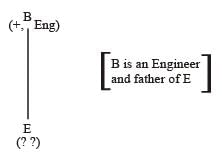
Now, we move on to another sentence that involves either B or E. You see that the 5th sentence gives some information about E. It says that D is the grandmother E. Point to be noted that if D is the grandmother of E, then the son of D must be father of E and hence B is the son of D. Now, the diagram takes the following form.

Now, the 4th sentence has the remaining information and diagram for it is given below:

Now, we see that we have ended up with two different component. Then how to resolve this deadlock? The answer is simple— to resolve it we make used of the given useful secondary information (USI).
“There are two married couple in the family.” Clearly, the two possible pairs are of grandfather, grandmother and father, mother. Therefore, we combine the two diagrams into the following way.
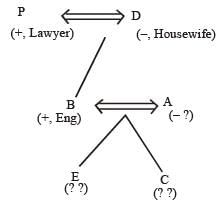
Point to be noted that the professions of A, E and C are yet unknown. However, with reasonable justification, we may assume that the mother (A) should be the teacher and the two children E and C should be students. But this conclusion can be challenged and has no reason at all.
Apart from that the sexes of E and C can not be determined.
Now, read the question and check your answer one by one:
Report a problem
Question for Tips & Tricks: Puzzle Test
Try yourself:Who is the sister of E?
Explanation
Here, (i), (ii), and (iv) are useful secondary informations. While (iii), (iv) and (v) are the actual informations. We start with the 3rd sentence because it mentions a parent. Child relationship its diagram can be made as the following:
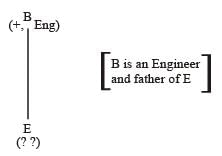
Now, we move on to another sentence that involves either B or E. You see that the 5th sentence gives some information about E. It says that D is the grandmother E. Point to be noted that if D is the grandmother of E, then the son of D must be father of E and hence B is the son of D. Now, the diagram takes the following form.

Now, the 4th sentence has the remaining information and diagram for it is given below:
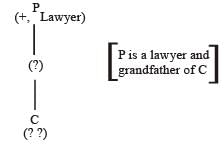
Now, we see that we have ended up with two different component. Then how to resolve this deadlock? The answer is simple— to resolve it we make used of the given useful secondary information (USI).
“There are two married couple in the family.” Clearly, the two possible pairs are of grandfather, grandmother and father, mother. Therefore, we combine the two diagrams into the following way.
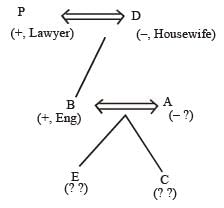
Point to be noted that the professions of A, E and C are yet unknown. However, with reasonable justification, we may assume that the mother (A) should be the teacher and the two children E and C should be students. But this conclusion can be challenged and has no reason at all.
Apart from that the sexes of E and C can not be determined.
Now, read the question and check your answer one by one:
Report a problem
Question for Tips & Tricks: Puzzle Test
Try yourself:Who is the husband of A?
Explanation
Here, (i), (ii), and (iv) are useful secondary informations. While (iii), (iv) and (v) are the actual informations. We start with the 3rd sentence because it mentions a parent. Child relationship its diagram can be made as the following:
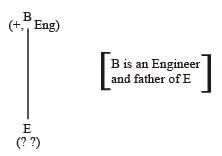
Now, we move on to another sentence that involves either B or E. You see that the 5th sentence gives some information about E. It says that D is the grandmother E. Point to be noted that if D is the grandmother of E, then the son of D must be father of E and hence B is the son of D. Now, the diagram takes the following form.
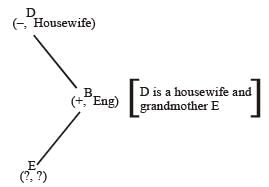
Now, the 4th sentence has the remaining information and diagram for it is given below:

Now, we see that we have ended up with two different component. Then how to resolve this deadlock? The answer is simple— to resolve it we make used of the given useful secondary information (USI).
“There are two married couple in the family.” Clearly, the two possible pairs are of grandfather, grandmother and father, mother. Therefore, we combine the two diagrams into the following way.

Point to be noted that the professions of A, E and C are yet unknown. However, with reasonable justification, we may assume that the mother (A) should be the teacher and the two children E and C should be students. But this conclusion can be challenged and has no reason at all.
Apart from that the sexes of E and C can not be determined.
Now, read the question and check your answer one by one:
Report a problem
Question for Tips & Tricks: Puzzle Test
Try yourself:Which of the following is definitely a group of male members?
Explanation
Here, (i), (ii), and (iv) are useful secondary informations. While (iii), (iv) and (v) are the actual informations. We start with the 3rd sentence because it mentions a parent. Child relationship its diagram can be made as the following:

Now, we move on to another sentence that involves either B or E. You see that the 5th sentence gives some information about E. It says that D is the grandmother E. Point to be noted that if D is the grandmother of E, then the son of D must be father of E and hence B is the son of D. Now, the diagram takes the following form.
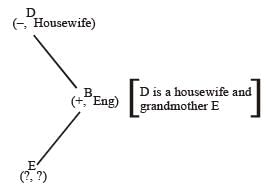
Now, the 4th sentence has the remaining information and diagram for it is given below:
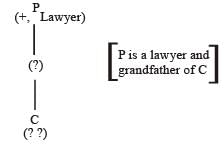
Now, we see that we have ended up with two different component. Then how to resolve this deadlock? The answer is simple— to resolve it we make used of the given useful secondary information (USI).
“There are two married couple in the family.” Clearly, the two possible pairs are of grandfather, grandmother and father, mother. Therefore, we combine the two diagrams into the following way.
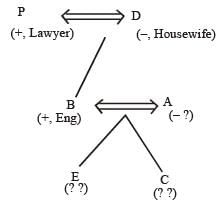
Point to be noted that the professions of A, E and C are yet unknown. However, with reasonable justification, we may assume that the mother (A) should be the teacher and the two children E and C should be students. But this conclusion can be challenged and has no reason at all.
Apart from that the sexes of E and C can not be determined.
Now, read the question and check your answer one by one:
Report a problem
Question for Tips & Tricks: Puzzle Test
Try yourself:What is the profession of A?
Explanation
Here, (i), (ii), and (iv) are useful secondary informations. While (iii), (iv) and (v) are the actual informations. We start with the 3rd sentence because it mentions a parent. Child relationship its diagram can be made as the following:
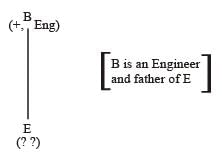
Now, we move on to another sentence that involves either B or E. You see that the 5th sentence gives some information about E. It says that D is the grandmother E. Point to be noted that if D is the grandmother of E, then the son of D must be father of E and hence B is the son of D. Now, the diagram takes the following form.
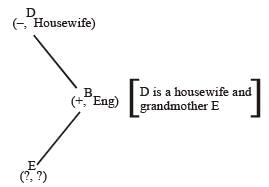
Now, the 4th sentence has the remaining information and diagram for it is given below:
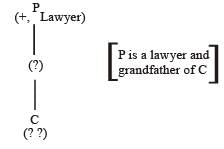
Now, we see that we have ended up with two different component. Then how to resolve this deadlock? The answer is simple— to resolve it we make used of the given useful secondary information (USI).
“There are two married couple in the family.” Clearly, the two possible pairs are of grandfather, grandmother and father, mother. Therefore, we combine the two diagrams into the following way.

Point to be noted that the professions of A, E and C are yet unknown. However, with reasonable justification, we may assume that the mother (A) should be the teacher and the two children E and C should be students. But this conclusion can be challenged and has no reason at all.
Apart from that the sexes of E and C can not be determined.
Now, read the question and check your answer one by one:
Report a problem
Problems based on Conditional Selection: In this type of problems, a group of objects/persons has to be selected from a given larger group, as per the given restrictions.
Directions: Study the following information carefully and answer the questions given below:
From, amongst 6 boys J, K, L, M, N, and O and 5 girls P, Q, R, S and T, a team of 6 is to be selected under the following conditions:
(i) J and M have to be together.
(ii) L can not go with S.
(iii) S and T have to be together.
(iv) K can not be teamed with N.
(v) M cannot go with P.
(vi) K and R have to be together.
(vii) L and Q have to be together.
Question for Tips & Tricks: Puzzle Test
Try yourself:If including P, the team has three girls, the members other than P are:
Explanation
Solving problems like example 6 is very easy. Make the group of all the pairs that have to be together on one side and the pairs that must not be together on the other side. Next, read each of the questions and treat that as an additional information. Finally analyse the possibilities and choose the possibilities that satisfies all the conditions. Let us see the process below:
1stly, we can summarise the conditions in the following way:
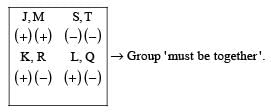
Group never be together

Now we move on to questions one by one.
There are three girls including P. P is there, so M must not be there. If M is not there, J would not be there. So two boys J and M are eliminated. Since, the team should have only 6 members, hence there should be three boys. Two boys J and M are eliminated. Therefore, the possibilities of selecting three boys are : KLN, KLO, KNO, LNO. But K and N can’t be together. Hence the remaining possibilities are KLO and LNO. Now, K must be with R and L must be with Q. Therefore, we have PKRLQO and PLQNO. To the 2nd possibility we need to add a girl. We can’t add R since R can’t go without K. We can’t add T since T can’t go without s. Conversely, we can’t add S either. Hence, this possibility is also eliminated. This, the only possible choice remains PKRLQO.
∴ correct answer choice is (A).
Report a problem
Question for Tips & Tricks: Puzzle Test
Try yourself:If 4 members including N, have to be boys, the members other than N are:
Explanation
Solving problems like example 6 is very easy. Make the group of all the pairs that have to be together on one side and the pairs that must not be together on the other side. Next, read each of the questions and treat that as an additional information. Finally analyse the possibilities and choose the possibilities that satisfies all the conditions. Let us see the process below:
1stly, we can summarise the conditions in the following way:
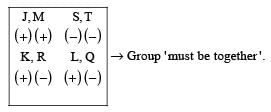
Group never be together

Now we move on to questions one by one.
Inclusion of N ⇒ Exclusion of K ⇒ Exclusion R. Four boys does mean there should be two girls. How do you select 2 girls out of P, Q, S and T if S and T have always to be together? The only two possible way are –P, Q, and S, T. If we choose P we can’t select M, and hence we can’t select J either. This means the exclusion of J and M in addition to that of K. Since, this is not possible in order to have four boys, we must not select P. Hence, we select S.T. Now,
selecting S means excluding L. Hence, K and L are excluded.
The team would be– JMNOST
∴ Correct answer choice is (B).
Report a problem
Question for Tips & Tricks: Puzzle Test
Try yourself:If there be 5 boys in the team, the lone girl member is:
Explanation
Solving problems like example 6 is very easy. Make the group of all the pairs that have to be together on one side and the pairs that must not be together on the other side. Next, read each of the questions and treat that as an additional information. Finally analyse the possibilities and choose the possibilities that satisfies all the conditions. Let us see the process below:
1stly, we can summarise the conditions in the following way:
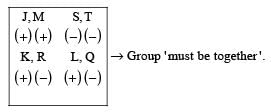
Group never be together

Now we move on to questions one by one.
Here, number of boys are 5. We see that K and N can never be together. Therefore, there are only two ways of selecting 5 boys – JKLMO and JNLMO. But the possiblity is not possible because if K would go then R should also go, and if L goes than Q should also go. Hence, JNLMO is the only possibility in which L’s friend Q would be the lone girl member.
∴ Correct answer choice is (B).
Report a problem
Question for Tips & Tricks: Puzzle Test
Try yourself:If, the team including L consists of 4 boys the members of the team other than L are:
Explanation
Solving problems like example 6 is very easy. Make the group of all the pairs that have to be together on one side and the pairs that must not be together on the other side. Next, read each of the questions and treat that as an additional information. Finally analyse the possibilities and choose the possibilities that satisfies all the conditions. Let us see the process below:
1stly, we can summarise the conditions in the following way:
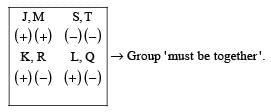
Group never be together

Now we move on to questions one by one.
There are 4 boys including L. So there must be two girls. Now if L is present, S can’t go and if S can’t go, T won’t go. Hence, three girls remain– P, Q and R out of these, two can be selected in the ways given below:
PQ, PR, and QR.
Now, if P is selected, M can’t go and if M can’t go, J will not go. In such case the team would have to include K and N as 4 boys hence to be selected. But K and N can’t be together. This means that P should not be selected. Therefore, the only possibility of selecting two girls is QR. But R means the necessary inclusion of K, which in turn means necessary inclusion of N. Hence, the possible combination is LKQR. To this we should add two boys out of J, M and O. The only possibility is adding J and M as neither of these would go without the other. Hence, the team is JMLKQR.
∴ Correct answer choice is (B).
Report a problem























































